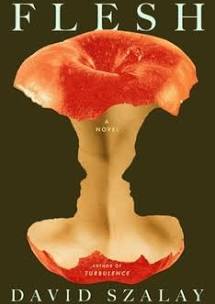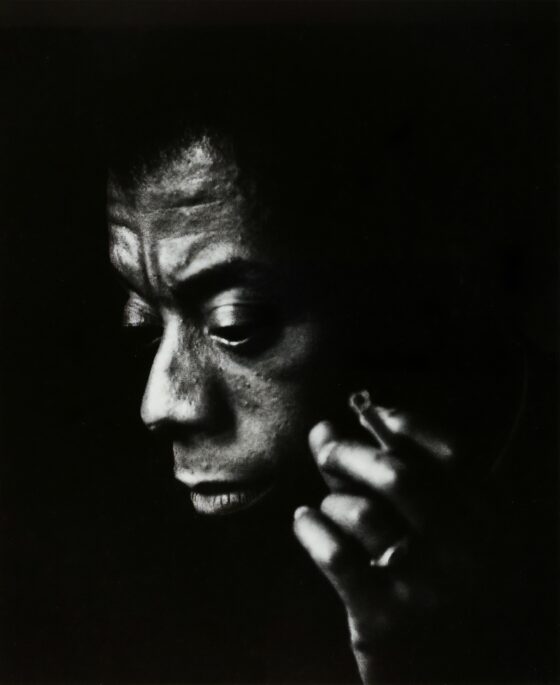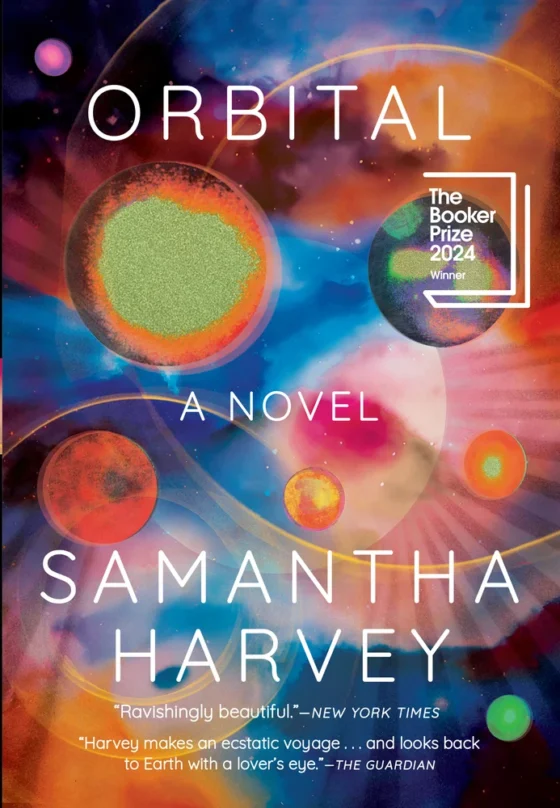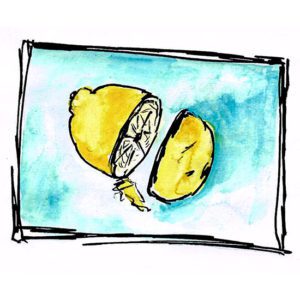
The thing about living with my ex’s mural of his own ex about two hundred feet from my apartment was that I loved it. She looked out sideways, lips parted as if she were about to speak. The first time I saw him, a year or two before we began dating, he was painting daisies in her hair. I found more images of her while I sat in his studio. He didn’t pay rent. A family had offered him the carriage house above their garage for free, and in return, he gifted them black-and-white paintings of birds. The studio was a small room, layered in indecipherable spray-painted phrases. He used the pointed ends of finished X-Acto blades to pin photos to the wall. There was no heat and no air conditioning, and I always suspected that, even if other families had offered other studios, he would have chosen this one anyway. Once, he asked what my type was, romantically, and the only unifying factor I could find between the people I had slept with was that a disproportionate number of them had jumped into frozen ponds for absolutely no reason at all.

Murals occupied a relatively small amount of his working time—they were completed in a few exhausting days—but they were what people knew. They were impossible not to know if you lived in Richmond, a small city that prided itself on being the artsy part of Virginia. When I moved there, I had wanted to be an artist too. I’d come for an illustration program, but I had also loved the city for its physical beauty, which he had, in part, created. His ornery black-and-white faces showed up in the background of maybe 10% of Richmond dating app profiles.
And still, I felt that asking him about his work drew too much attention to something vulgar. It made me pause on his Tinder profile, but it wasn’t what made me swipe. Of course, I knew who he was; I followed him on Instagram; I knew his painting of a twenty-foot topless woman on the side of my neighborhood diner; I knew that it was originally supposed to be a portrait of a girl who was tangentially connected to my group of friends.
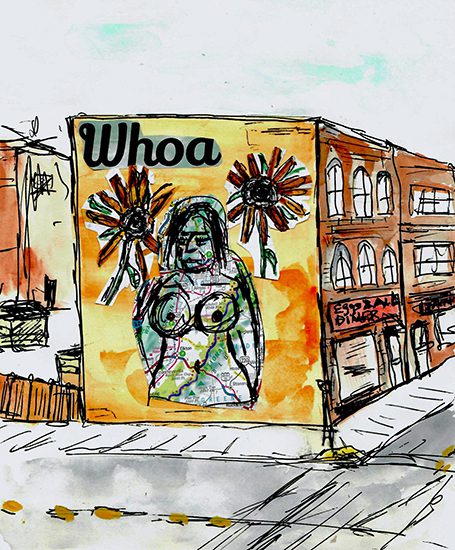
***
The story went like this: after the photos were taken and the design approved and the muralist had set up to paint, the girl changed her mind. Her boyfriend had teased her because the design was recognizably her and exposed her nipples. At the last minute, the muralist had to find another model before his lift rental expired. My roommate and I talked about this often as we passed the diner, the breasts distorted up close. We asked each other whether we’d want our own nipples to bless the town, if we’d see it as an honor or a liability.
Art was the muralist’s full time job. He’d received a grant that paid his expenses for six months after college, and in this time, built enough of a following to live off his work. He often bartered: a print for a new fish tank, a quick brewery wall for a few hundred dollars and a year’s supply of beer. He was usually lonely and disoriented. Some mornings he’d wake up and plant a hundred tulips. Once, in his studio, the muralist said something like, “I don’t consider myself famous,” and I laughed, because I hadn’t called him famous either, and maybe also because I assumed that he’d be more interested in me if I didn’t take on the role of fan.
I didn’t want the power imbalance that might come from acknowledging that, for me, the muralist existed in both a personal and mythologized capacity: the artist I’d always known, whose career I’d followed, and at times, envied, as well as the guy I met the summer I turned twenty-four when we split a bottle of wine in a sculpture garden and stayed up talking about the ways in which our childhood pets died (my cat had pancreatitis; his parakeets went “the normal way”). I couldn’t be the same for him; I was stuck as a regular person in my dumb mortal body.
We first kissed beneath a large sculpture of a woman whose face was designed to distort and flatten as you circled it. We broke apart when a man walked by with two poodles who started shitting a few feet away from us.
On our second date, we drove out to the country to get fireworks for a photo series. He told me that there was a nearby aquarium he loved, which he soon revealed was actually just a fish store. I thought of a friend, who had once said that she imagined the purpose of her life was to live in a way that made a good story, who imagined herself in a book in lieu of a world with a god. It was easier to leave one observer behind if you submitted to another—it was much more lonely and existentially frightening to wake up every morning in a world where you felt unwatched. Years later, the internet would dub this “main character syndrome.” We squeezed through the aisles, reading handwritten labels beneath glowing shrimp. I thought: This is a person who knows how to enjoy the world.
Strangers would send the muralist unsolicited critiques of long-finished paintings, as well as deeply personal messages about their own lives. One woman asked if he’d paint her friend because the friend’s husband had cheated on her, and she thought he deserved to pass her face every day. Some people would send unprompted nudes of themselves, in hopes that he’d be so moved by their bodies he would have no choice but to memorialize them. A Belgian guy sent a DM about drunkenly peeing on his mural at night. The muralist thought this one was pretty funny.
His generic message responding to compliments used the term “very kind.” I thought the boilerplate reply was distant. Overall, he said he genuinely felt separate from his work. The walls didn’t even look like faces to him anymore in any meaningful way, just a mess of values.
I understood this, to an extent. I used to think I’d work in art too—I met the muralist not long after letting that go. Once, my high school French teacher asked the class to go around and write compliments for each person. When I unfolded my slips of paper, nearly all of them said that I was a good artist. I was crushed. I wanted to hear that I was funny or beautiful, or that being around me felt good. Drawing was a skill linked to practice and elongated visual memory. It was like being told: The best thing about you is how well you juggle, or, The best thing about you is that you run really fast.
I’d picked up art as a kid, because I was horribly shy and spent a lot of time alone. As I got older, I learned that if I doodled an eye in the margin of my homework, then someone would notice, would come over and talk to me, would ask me to draw them and sit still and spend time with me while I did. Even if I had no idea how to start a conversation, I could lure people over by offering a vision of themselves. Years later, I wondered if I’d ever really liked drawing, or if I’d only liked being good at something.
I couldn’t say if I truly liked making art or not, but around the muralist, I did feel a heightened love of beauty. In the grocery store, I picked up Meyer lemons to show him, and he knew when I presented him with them what I was saying: that they were the absolute perfect yellow; the yellow I felt closest to; one of my favorite things in the world. This was all real, but it was also something he drew out of me. While driving, he’d point to an orange field under the clouds, and I would know what he was saying as well. We laughed about people who treated artists like they were conduits to higher powers, but we’d also have sex and he’d scatter a jar full of petals over my naked body afterwards, and we’d say to each other, Isn’t this art, too? I couldn’t tell if we were being sincere. He carried me on his back through a yellow-lit cobblestone alley, an alley which we referred to as Paris. In the car, he’d look over while I was going on about a guy I knew who never wore blue jeans because he hates the color blue, as if there’s anything to dislike about blue besides its mildness. I saw him turn to me like I was the orange field disappearing into sky.
It wasn’t until a New Years party in a Richmond backyard that I understood the muralist wasn’t making it up, the way the city’s gaze followed him. Sometimes he complained about how this manifested in his day-to-day life. Artists, he claimed, would treat him differently: like someone who it was beneficial for them to know. I knew this change was stressful but, also, I obviously thought he was humble-bragging. At the party, we stood together as hundreds of tea candles reflected in metal buckets. I considered that I might be cooler than I had previously thought. I imagined that I was no longer a girl who once had to bribe people into friendship with colored pencil portraits, that I never had been. If he painted me right then, this would be the version of my life on the official record.
A guy in the circle began gushing to the muralist about how his work was transforming our city, how it gave this man pride to share a hometown with him. I knew he was making the muralist uncomfortable; I knew he wouldn’t know how to reply. I thought: I am too high to be here. I thought, Has nobody told this guy about being cool? I squeezed the muralist’s hand and tried to psychically transmit: I’m watching this happen, too.
This is why I couldn’t be a fan, couldn’t be the guy at the party waving around his praise for anyone to see, whose attention solidified both the muralist’s position as artist, as describer, and his own position as viewer, as receiver, as the one who wanted more. And still, there was a choice: remaining the main character in a life where I walked around and went to work and didn’t do much, or becoming a side character in a much more interesting story—in something people might actually read.
A girl at the party—a muralist with a smaller following—went to get a beer. On her way out, she ran her hand down the muralist’s back, like an early 2000s movie villain— even though I was right there, holding his hand inside my pocket. I hated her in that moment, with a pleasurable type of rage. She was looking at him, and he was looking at me. He’d made a career out of his gaze—one that people followed, their attention making him a rarefied observer who they looked to to tell them what was real, what belonged to the world of art and ideas. I wanted to live inside that world, and when he looked at me, I did.
When the muralist came to my apartment, I used to sneak him through my bedroom window, not because we had to, but because I lived on the first floor, and because we could, and because he was a person who understood whimsy and fun. When he left for Amsterdam, we tried to lucid dream so we could still be together. There is still beauty, I want to say, when no one is watching, but I could never stop watching him, watching myself, evaluating our dreams, praising them.
Maybe it was all worth it. When he broke up with me for vague reasons—something about an artist residency in Berlin that he hadn’t even been accepted to yet—I was wrecked. The following morning, I woke up too sad to get up to pee, even though I really needed to. I couldn’t rise and meet my new reality, a world where I couldn’t be the Meyer-lemon-yellow version of myself anymore.
Why we broke up and I went back to him, over and over is a lot like the story of how every emotionally unavailable couple ebbs and flows. He wanted to move to Amsterdam; I wanted to go to grad school. He panicked whenever the intimacy of our relationship reminded him of previous relationships and the hurt they caused. And I must have panicked at the thought of real closeness too because I kept choosing someone who couldn’t offer it.
That autumn, he painted an enormous portrait on a building that had once held an ice plant in a nearby town. At this point, we were quasi-back together. A week earlier, we’d swam naked in the river, but we’d been down this path enough to know it wouldn’t last. The ice plant project had started years before, and so he was painting a design he’d planned a long time ago. The woman looking mournfully over the field was his ex: a woman who was an artist herself, who had chosen to leave this man and this town, who, I assumed, would never write herself as a secondary character. The muralist referred to me as a writer, which was true: I wrote content for websites about drug trial recruitment and marketing copy about focus group incentives. I wanted to write something bigger, but I wasn’t sure what that meant or whether anyone truly wanted to read poems about finding dead birds at my grandmother’s house, and why I kept writing them if they didn’t. Sometimes I wondered if the muralist forgot that I painted too. His ex-girlfriend’s bangs were wet; tulips emerged from her hair. How ugly a desire, to want the exact gift he’d given her. How badly I wanted it anyway.
He had given me one mural-adjacent thing. First, it’s important to know how his mural process worked: he would begin by spraying a haphazard array of neon pink doodles on the wall, which he would then photograph and upload onto his computer. At this point, he’d select and overlay the doodles on his design, as a type of grid to help orient him. Once, back when we were dating, he flew to Germany to paint a man who had been killed in the Holocaust. The grid beneath the man’s face is full of squiggles and Xs and hearts, but there’s also a doodle of my first name hovering somewhere beneath his eyebrow. It was an outlandishly inappropriate romantic gesture, but I figured, at least I was actually Jewish. I’d take what I could get.
In the months that we were broken up, any time he painted a new mural in town, I’d pass his grid and look for myself in it, like a code. How could I not? The ice plant portrait of his ex-girlfriend was disparaged by locals who thought she looked too sad, but also chosen by a street art organization as their favorite mural of the year.
***
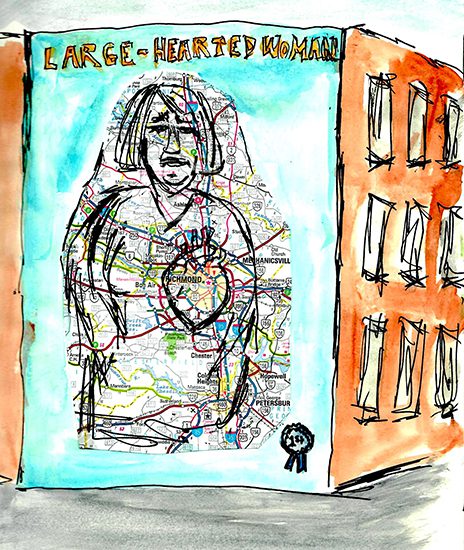
The muralist had one primary career goal and it was simply to paint as large as possible. It wasn’t because these walls would be seen by more people, he said, but that each escalation felt like a challenge, a game. He began at the start of adolescence, and has never stepped away. Every night before bed, he put his X-Acto-blade-wielding wrist in a splint.
He was generally ambivalent about the idea of fame, and tried to avoid appearing in his own social media. Recently, a friend and I were talking about whether or not we’d ever want to be famous. It seems obvious that being watched by a great number of people is bad for you, that fame reliably harms those who achieve it. A former reality star we follow on Instagram, we agreed, would probably be much happier if she weren’t constantly justifying her parenting choices to strangers and lived anonymously as an artsy mom. The influencer’s toddler recently started teething on an unused vibrator and everyone was upset. Wouldn’t it be better to just avoid that?
And still—how could I say I don’t want this regard when I’m doing what I’m doing? How can I act like I don’t think that being watched by a large number of people offers my life some legitimacy? When I’m still trying to put my mind and face in the public sphere, longing for murals and readers and proximity to fame? I’m still actively trying to be under that gaze, watched by people who haven’t met me. How do you separate the desire to make art from the desire to be seen? I have to believe there’s more to it all than this, but if I painted a billion foot wall, it would only be so that nobody could ever look away from me.
***
On Instagram, the reality star posts her morning banana to half a million followers. She preemptively adds a link to the headband she’s wearing, because she knows people will ask. I imagine how it feels to know that someone thinks that the way you arrange your refrigerator is, somehow, interesting. When the muralist popped a seltzer for me before I came over because he remembered I prefer them half-flat, I thought it was the most romantic thing in the world.
During one of our break ups, he said to me: This is how I’ll always think of you, how you look right now, with your face half in a pillow. I can never tell what you’re thinking about. This is obviously what I wanted my mural to look like. I wanted to not only be seen, but seen through the eyes of someone who was at least halfway in love with me—even if I felt most desired in the moment he told me he didn’t understand me. My idea of love depended, and to some extent, still depends upon this distance, this unbridgeable space in which to throw our longing, the inaccessibility that surrounds everyone who has ever captivated me, every lover, every star. I wanted to grow old and tell this story to my grandchildren and show them this mural, this monument to what my face looks like when I’m trying not to cry. I wanted to walk around in a gown saying, “You know, I was once very beautiful,” because it’s of crucial importance to all children that their grandparents are formerly hot. Anyway, I actually wasn’t thinking about anything at all. The only thing on my mind was a primal want for him to stay.
I never got my mural, although I tried. Over the years, I lost patience with my cool shtick, and just asked. He said he’d paint whatever I wanted if I found a wall for it. This past summer, I wrote a proposal in response to a call for muralists, explaining to a committee why I needed him to come paint my face really big on the side of a bar I go to often. We made the final rounds, but the design wasn’t accepted. Nothing has shown up in its place. Before the rejection, friends asked if I was sure I wanted my face so huge, right where everyone could see it. I couldn’t even imagine not wanting that, although I did feel embarrassed by how swollen my desire had grown. I haven’t stopped hoping for this mural, and if I heard of an open wall, I’d take it today. If you know one, tell me.
In the depths of my melodrama, I’d walk around Richmond under the gaze of his murals, and remind myself: This isn’t the whole world. One day, I told myself, I’m going to move somewhere new and nobody I’ll meet will have heard of him. I’ll climb a big hill and sit at the top with friends I haven’t met yet, and I won’t be able to imagine caring about what I care about now. I will half-heartedly disguise his identity, as if fame retains value when stripped from its context. He’ll still be a character, but smaller. I will be the one committing him to page, gazing at him, gazing at the shape I took around him: an outline, a portrait, a mural, a single shot with our faces mostly turned away. The story will continue without him. I’ll stay in a cabin in the darkest part of Iowa and watch a meteor shower in the damp grass until a cloud obscures what we drove out for. I’ll fall asleep in my contacts. I’ll bite into an apple and find that it’s smushed from the car and think of a tree he once planted that never bore fruit. I’ll think of him carrying me through the yellow alleyways. I’ll think of our arms outstretched from either side of a snowbank and it will light up very little in me or maybe nothing at all. These friends will have to take my word for it when I say there’s a place where all of this matters. This trust will be a kindness.
***
Rumpus original art by Peter Witte



